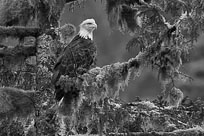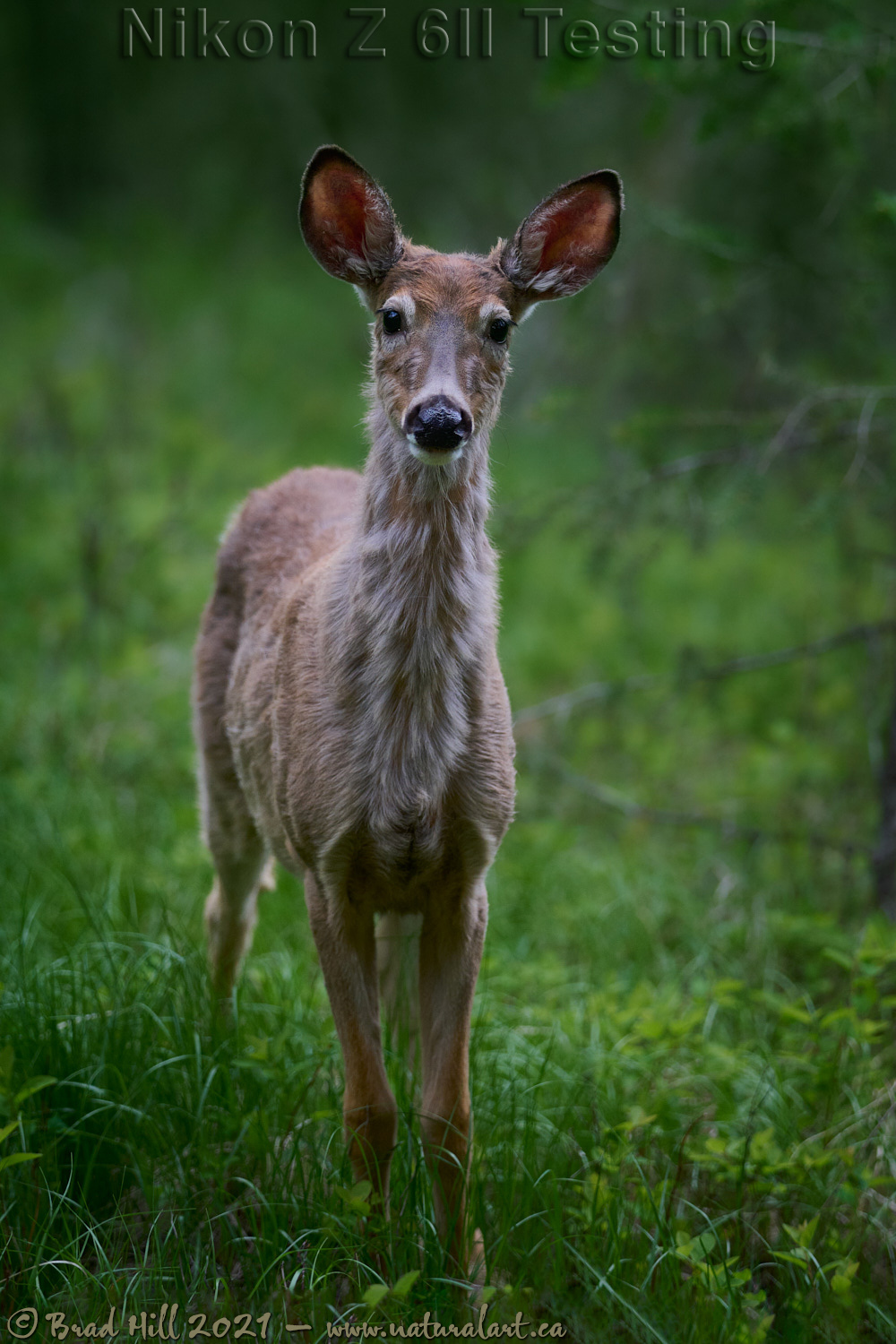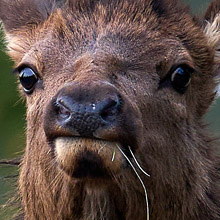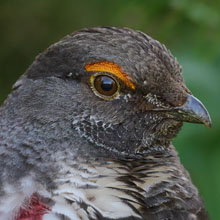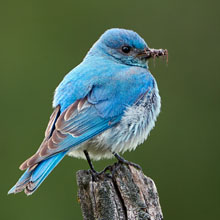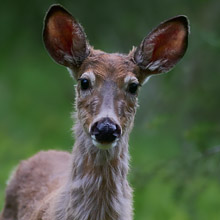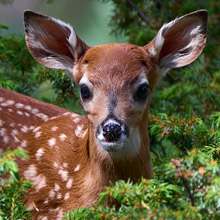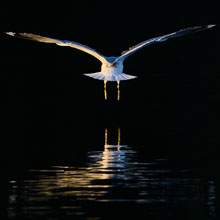Availability: Undetermined - Enquiries?
In the Field
Z 6II Testing - The Scruffy Yearling. Findlay Creek Region (East Kootenays), British Columbia, Canada. May 22, 2021.
This is my tenth gallery post detailing my experiences with shooting wildlife using the Nikon Z 6II. The subject in this case is a yearling White-tailed Deer that is partway through trading its thick, warm winter coat in for a sleeker, cooler (and more colorful) rust-colored summer coat. While over a lot of the body the young doe looks on the scruffy and kinda ratty...but I have to say the shedding pattern in the facial region adds some interest to the shot (at least to me!). You'll probably have to download and examine the larger version of the image (below) to see what I mean...
In a way I kinda got away with screwing up royally on this shot. At time I was shooting my Z 6II with a 120-300mm f2.8E lens on it - with a TC-14EIII (1.4x) teleconverter on it. Now, there's nothing wrong with shooting that combination to get to focal lengths in the 300-420mm range...it performs pretty darned well. And, at least in my opinion, it works particularly well when shot with either the Z 7II or Z 6II (I THINK owing to how the AF system of Nikon's mirrorless cameras work).
So how did I screw up? Well, when I first saw this fawn in soft, pre-dawn light it was at a distance where I wanted to shoot with a little more than 300mm. So I grabbed my 1.4x TC out of a pouch on my waist and quickly added it to the back of the 120-300mm f2.8E. All good, so far. But this yearling has got to be one of the most curious young white-tails ever to roam the planet...and it saw me just about the time I raised my lens. And, while I was watching her through my viewfinder she literally trotted right up to me, to the point where I had zoomed the lens WAY back (to just under 165mm, or 230mm with the TC factored in). So basically I was shooting at a focal length within the "native" range of the lens, with the TC simply adding additional and unnecessary glass into the equation (along with reducing light).
Of course, this isn't the first time I've been "hung" with either too long of a prime lens or with a TC on a zoom lens when I didn't need it. In the not-so-distant past (i.e., when shooting a DSLR) getting hung with an unneeded TC in place meant your image quality took a pretty big dip. Fortunately, because the new mirrorless Z-series cameras perform that much better with TC's than Nikon's DSLR's do, the "penalty" you face when getting "hung" with TC on Zed camera is pretty minimal. Lucky me! ;-)
Here's a considerably larger version (4800 pixel) of this scruffy little doe:
• The Scruffy Yearling: Download 4800 pixel image (JPEG: 5.7 MB)
ADDITIONAL NOTES:
1. This image - in all resolutions - is protected by copyright. I'm fine with personal uses of them (including use as desktop backgrounds or screensavers on your own computer), but unauthorized commercial use of the image is prohibited by law. Thanks in advance for respecting my copyright!
2. Like all photographs on this website, this image was captured following the strict ethical guidelines described in The Wildlife FIRST! Principles of Photographer Conduct. I encourage all wildlife photographers to always put the welfare of their subjects above the value of their photographs.
Behind the Camera
Z 6II Testing - The Scruffy Yearling. Findlay Creek Region (East Kootenays), British Columbia, Canada. May 22, 2021.
Compressed RAW (NEF) 14-bit format; ISO 1800.
Nikon Z 6II paired with Nikkor 120-300mm f2.8E plus TC-14EIII (1.4x) teleconverter (total focal length of 230mm). Hand-held. VR on and in Sport mode. Single Area AF area mode.
1/200s @ f4; -0.3 stop compensation from matrix-metered exposure setting.
At the Computer
Z 6II Testing - The Scruffy Yearling. Findlay Creek Region (East Kootenays), British Columbia, Canada. May 22, 2021.
RAW Conversion to 16-bit PSD file (and JPEG files for web use), including all global and selective adjustments, using Phase One's Capture One Pro 21. Global adjustments on this image were limited to a single tweak to brightness. Selective local adjustments performed using Capture One Pro's layers and masking tools. In this case selective adjustments were made on 8 separate layers and included one or more tweaks to color (using the Color Balance tool), clarity, shadows, blacks, and brightness.
Photoshop modifications were limited to the insertion of the watermark and/or text.
Conservation
Z 6II Testing - The Scruffy Yearling. Findlay Creek Region (East Kootenays), British Columbia, Canada. May 22, 2021.
Species Status in Canada*: This species is not designated as at risk.
White-tailed Deer (Odocoileus virginianus) are one of the most widely distributed mammals in North America - they can be found in virtually all of southern Canada and in most of the American states. While whitetails are common now, in the late 1800's they were in serious risk of extinction - their populations had been reduced from about 40 million (across North America) to under 500,000. The conservation effort to return whitetails to numbers sufficient for long-term survival was massive and included strict harvest regulations, intense management, reintroductions, and habitat protection. Today, most populations in the United States do not represent original stock and the distinction of most historical subspecies is uncertain.
Whitetails resemble Mule Deer quite closely, and the two species overlap in distribution in western North America. The two species tend to prefer different habitats, with whitetails occupying more heavily forested land and along river valley bottoms, while muleys tend to prefer uplands and montane areas. On rare occasions, the two species will interbreed. Occasionally the offspring are fertile, but in most cases they are sterile.
This whitetail fawn was photographed in the Columbia Valley of the East Kootenays. While this species is not currently considered at risk, many ecosystems within the Columbia Valley face development pressure, including pressure from logging operations.
*as determined by COSEWIC: The Committee on the Status of Endangered Wildlife in Canada










